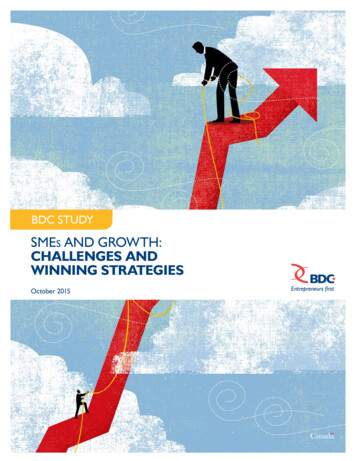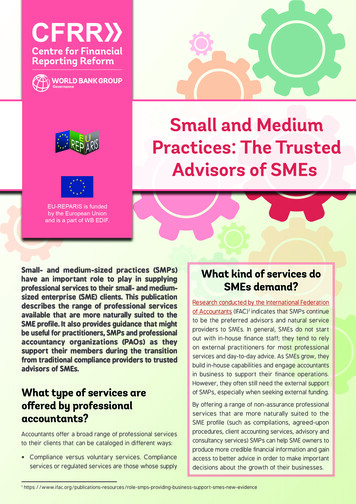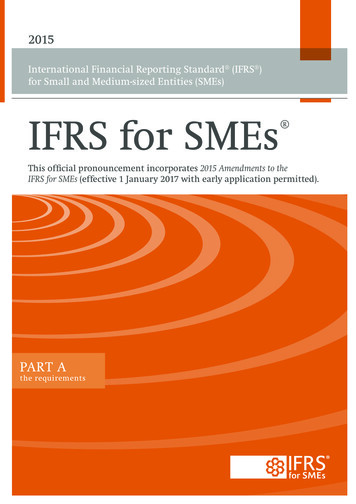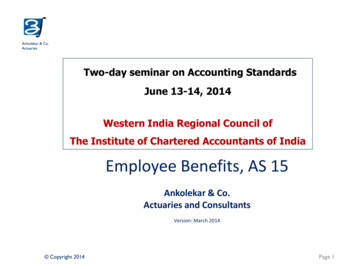
Transcription
BDC STUDYSMEs AND GROWTH:CHALLENGES ANDWINNING STRATEGIESOctober 2015
------------------------------------------- --------------------------------------------- 31. Revenue, profit and jobs:The three dimensions of --------- 62. To grow or not to grow:A question of ----------------------- 93. Why -----------------------------------104. Challenges for day-to-day ------125. Keys to growth:Winning strategies according to SME rvey -------------------------------26This research was prepared by the Economic Analysis team from Marketing and Public Affairs.Reliance on and use of this information is the reader’s responsibility.Copyright 2015 Business Development Bank of Canada1 888 INFO BDC bdc.ca
SUMMARY4 /10SMEs ARESUCCESSFULLYMEETING THECHALLENGESASSOCIATEDWITH GROWTH.12%OF CANADIANSMEs AREEXPERIENCINGSTRONG GROWTH.29%OF CANADIANSMEs AREEXPERIENCINGSUSTAINEDGROWTHIN TERMS OFREVENUE, PROFITOR NUMBEROF EMPLOYEESFOR 2015.bdc.ca Regardless of whether a business is seeking to make it past the start-up phase, satisfy amajor increase in demand for its products and services, or strengthen its competitiveposition, growth is a vital step in the development of a small or medium-sized enterprise(SME). How many Canadian SMEs are pursuing growth in Canada in 2015? What are theobstacles they face? And what are the most commonly used strategies for overcomingthose obstacles? To answer these questions, we spoke with entrepreneurs from a variety of backgroundswho have put various strategies into effect with conclusive results. This, in turn, led to asurvey of over 1,000 SME leaders across the country to gain a better understanding ofgrowth challenges and identify the most promising strategies. Although every business has to chart its own path according to its size, industry andlocation, a number of findings were made that paint a general picture of how SMEs arepositioned vis-à-vis growth. The first finding of note: four out of 10 SMEs are successfully meeting the challengesassociated with growth. In Canada, 12% of SMEs experience strong growth in terms ofrevenue, profit or number of employees, while 29% show sustained growth. While not all businesses are at the same stage of development, there is a broadconsensus when it comes to the value of growth. The survey respondents (all categoriescombined) gave it an average score of 7.1 out of 10 in this regard. Another finding: SME leaders are facing challenges on many fronts, a fact that cansometimes thwart their ambitions. Among other things, they must contend with amarked increase in operating costs along with greater pressure on managers andemployees resulting from the efforts required to increase production. In some cases,debt loads and difficulty securing financing pose further obstacles. Despite the challenges, managing an expanding business can have substantial benefits.First, when revenue and profit levels grow, leaders’ personal and family financialsituations also improve. Another benefit worthy of note is that the ability to handle biggerprojects can make work much more stimulating for employees. And a growing businessis generally on a sounder financial footing, enabling it to compete more aggressively andpursue development projects. BUSINESS DEVELOPMENT BANK OF CANADASMEs and growth: Challenges and winning strategies PAGE 1
While the challenges vary from one business to another, there is a consensus on thestrategies for growing successfully. Leaders whose businesses are experiencing markedgrowth identified the following four winning strategies, in this order:1.2.3.4.Be a client-centric businessBuild your talent poolStay on top of your game, innovateInvest to be the best Since SMEs are the engine of the Canadian economy, it would be in everyone’s interestfor more and more of them to pursue growth. And one of the objectives of this study isjust that: to give SME leaders the desire to grow by providing relevant information andexamples that show that, with careful planning, success is within their reach.INENTSVIOPLNOYEESCLIESTATEMNOMINVESNTbdc.ca BUSINESS DEVELOPMENT BANK OF CANADASMEs and growth: Challenges and winning strategies PAGE 2
INTRODUCTIONRegardless ofwhether a businessis seeking to makeit past the startup phase, satisfya major increasein demand orstrengthen itscompetitive position,growth is a vital stepin the developmentof a small ormedium-sizedenterprise (SME).In theory, growth is one of the inevitable phases of a business’s lifecycle, which begins withthe start-up phase, followed by development or growth. Next comes maturity, whichcan lead either to the business’s decline or to its renewal. In practice, the life of a businessdoes not advance quite so predictably, and every business follows its own path. A businessmay complete its start-up phase very quickly, for instance, or may never reach maturity.However, as the research clearly shows, all businesses, whatever their size, location orindustry, are likely, one day or another, to have to take steps to manage their growth.1Why focus on the growth of SMEs?Before looking at growth from the perspective of its inherent challenges and the strategiesfor managing it effectively, we should understand why it is important to put in place thenecessary conditions for SMEs to grow.The growth of SMEs is one of the main keys to an economy’s vitality. SMEs are knownto have a major role in creating wealth, given their place in the economy. In Canada, as inmany other countries, almost all businesses are SMEs.2 Moreover, 71% of the jobs createdin the private sector over the last 10 years can be attributed to the activities of SMEs.3Consequently, it comes as no surprise that governments seek to maintain a businessclimate conducive to the birth and growth of SMEs. The measures most often takenfor this purpose include reducing administrative burdens, introducing tax measures thatpromote growth and ensuring access to financing.However, while the business environment may play a leading role, the growth of SMEsdepends on a number of other factors as well. Every SME is unique and has its ownhistory based on its origins, industry, location and target market, but they all have certainpoints in common that enable some of them to fare better than others. That is theexpress purpose of this study: to identify strategies that explain the difference betweenbusinesses that are experiencing sustained growth and those that are stagnating or seeingtheir revenue decline. These are referred to here as “winning strategies.”1 C. Parsley and D. Halabisky, Profile of Growth Firms: A Summary of Industry Canada Research, March 2008.2 Private-sector businesses with 1 to 499 employees make up 99.8% of all businesses, according to data from Statistics Canada’sDecember 2014 Business Register.3 Calculated on the basis of data from Statistics Canada’s Survey of Employment, Payrolls and Hours (SEPH) for 2005 to 2014.bdc.ca BUSINESS DEVELOPMENT BANK OF CANADASMEs and growth: Challenges and winning strategies PAGE 3
The managementteam has to beable to manage thegreater complexitythat comes withgrowth and toexercise leadershipof all personnel.SME growth determinantsSeveral studies have focused on factors that foster the growth of SMEs. Last year,under the direction of Louis Jacques Filion, HEC Montréal’s Centre for Productivity andProsperity published an excellent summary of the literature on the subject, particularlyfrom the perspective of growth determinants and the means of sustaining growth.Unsurprisingly, this in-depth analysis of the literature shows that the main foundation fora business’s growth is its leaders’ will and commitment. Without the management team’sdetermination to grow the business, growth simply does not occur.But the desire to grow is not the whole story. A business must also have the capabilityto grow. The management team has to be able to manage the greater complexity thatcomes with growth and to exercise leadership of all personnel.What’s more, the business itself must be able to meet the challenges of growth. Thisis not only a matter of having qualified personnel, but also of fostering cooperation andhelping employees adapt to the frequent changes associated with growth. In addition,leaders must be able to capitalize on highly advanced equipment and technologies, andensure that employees receive the training they need to become proficient in their use.They must also have a solid understanding of their market and clients’ needs in order toadapt and innovate, whether by introducing new products and services or by upgradingtheir business processes and models. The business’s financial capacity must also beconsidered. Sustaining growth requires significant resources, and the business has tobe able to generate sufficient cash flow or make its operations more profitable whilecontinuing to be backed by solid financial partners.Lastly, successful growth can also depend on factors outside the business’s control,especially the environment in which it operates. The prospects are much better whenthe business enjoys such favourable conditions as increased demand for its products andservices, access to a qualified workforce, the existence of a solid supplier network, andthe proximity of research centres. As studies show, knowing how to recruit and utilizeexternal expertise—through an advisory committee, for example—can go a long waytoward ensuring that SMEs succeed.4In other words, there is ample literature to confirm that the growth of SMEs depends ona variety of factors. They range from aspects inherent to the business to others that aremore related to its ability to seize opportunities afforded by the external environment.4bdc.caBDC, Advisory Boards: An Untapped Resource for Businesses, 2014. BUSINESS DEVELOPMENT BANK OF CANADASMEs and growth: Challenges and winning strategies PAGE 4
Canadian SMEs and growthBased on the findings from this review of the literature on the growth of businesses hereand elsewhere, we set out to describe the situation of Canadian SMEs. Our first goal wasto identify the characteristics shared by SMEs experiencing growth.To this end, we sought out the answers to a series of questions to cover every aspect ofthe paths taken by SMEs who have set their sights on growth. What motivates a business’s leaders to seek growth? What are the advantages of growth? What are the main challenges and obstacles associated with growth? What strategies and best practices promote growth?To answer these questions, we first conducted in-depth interviews with the leadersof 25 businesses across the country, most of which were SMEs experiencing markedgrowth. Using the information obtained, we designed a questionnaire for a survey of1,015 SMEs.5 To illustrate the main findings of our research, we also selected examplesof Canadian SMEs that succeeded in meeting their growth objectives.Ultimately, this research allows us to paint a comprehensive picture of what growth meansfor businesses and prepare a list of strategies proven effective. By doing so, BDC hopes toassist the greatest possible number of SMEs that decide to pursue the path of growth. Andsince SMEs are our main economic engine, the entire country will benefit.5bdc.caA more detailed description of the survey methodology can be found at the end of this report. BUSINESS DEVELOPMENT BANK OF CANADASMEs and growth: Challenges and winning strategies PAGE 5
1.REVENUE, PROFIT AND JOBS:THE THREE DIMENSIONS OF GROWTHRevenue, profit and jobs are the three dimensions most often cited when determining towhat degree an SME is growing. The entrepreneurs interviewed for our survey and theother sources consulted all view growth from one or more of these perspectives.Accordingly, for the purpose of this study, we have decided to focus on the following criteria:To be deemed to be growing, a business must have seen an increase in its revenue, profit orworkforce in each of the last three years without having experienced any decline in any ofthese areas.Average annual growth of 5% to 19.9% will be considered “sustained growth,” with averageannual growth of 20% or more considered “strong growth.”Based on these criteria, our survey showed that 12% of Canadian SMEs are experiencingstrong growth, and 29%, sustained growth. However, six out of 10 SMEs (59%) showedweak or zero growth, or even negative growth, over the last three years.Figure 1: Four out of 10 SMEs are experiencing sustained or strong growth12%29%59%Strong growth in revenue,profit or the number of employees( 20%*)Sustained growth in revenue,profit or the number of employees(5% to 19.9%*)Weak (under 5%),zero or negative growth* Average annual growth over the last three years.Source: Ad Hoc Research, Survey on the Growth of Canadian SMEs, June 2015, n 1,015.bdc.ca BUSINESS DEVELOPMENT BANK OF CANADASMEs and growth: Challenges and winning strategies PAGE 6
30%OF SMEsEXPERIENCINGSTRONG GROWTHHAVE KEPT THEIRNUMBER OFEMPLOYEES ATTHE SAME LEVEL.Growth and productivity improvementsA detailed analysis of each of the three dimensions of growth shows that revenueincreases faster than profit and the number of employees, in that order. It is worth notingthat nearly a third (30%) of SMEs experiencing strong growth have kept their numberof employees at the same level. Most growing businesses have seen their revenue andprofit increase faster than their number of employees, suggesting that their productivityhas improved.Figure 2: R evenue and profit increase faster thanthe number of employees*9%30%7%6%10%27%11%Strong growth( 20%)Sustained growth(5% to 19.9%)25%23%Weak growth( 0% to 4.9%)54%Zero growth(0%)21%22%17%19%20%RevenueProfitNumber of employeesNegative growth( 0%)* Average annual growth over the last three years.Source: Ad Hoc Research, Survey on the Growth of Canadian SMEs, June 2015, n 1,015.Percentages may not necessarily add up to 100% due to rounding.Growth and business sizeMedium-sized businesses (100 to 499 employees) seem better able to manage growth.Over half (54%) of them have managed to maintain a sustained or strong pace of growthover the last three years. On the other hand, the results point to less favourable growthconditions for the smallest businesses (one to four employees). More of them (46%) showzero or negative growth.Figure 3: G rowth conditions are less favourable for small businesses*4643312637343124Negative or zero292620Weak( 0% to 4.9%)17111186Sustained(5% to 19.9%)Strong( 20%)1 to 4employees5 to 19employees20 to 99employees100 to 499employees* Average annual revenue growth over the last three years.Source: Ad Hoc Research, Survey on the Growth of Canadian SMEs, June 2015, n 1,015.bdc.ca BUSINESS DEVELOPMENT BANK OF CANADASMEs and growth: Challenges and winning strategies PAGE 7
Which businesses are experiencing strong growth?Businesses experiencing strong growth can be found in every size category, with noparticular distinctions.6Interestingly, the period of strong growth most often occurs in the first 10 years of thebusiness’s existence (19%, compared with an overall figure of 12% for businesses ofall ages). After 20 years of existence, businesses experiencing strong growth are lessnumerous, at 9% of the total.The results also show that an economy’s vibrancy can have an influence on businesses’ability to register marked growth. For instance, Alberta SMEs have been able to capitalizeon favourable conditions over the last three years; 23% of the province’s respondents areexperiencing strong growth.In terms of industries, construction leads the pack, accounting for 22% of businesses thatmeet the criteria for strong growth.The last point that characterizes businesses experiencing strong growth is that theirleaders are more optimistic regarding the future. Nearly a third (32%) of them anticipatean increase in business revenue of over 20% in the coming year, compared with just 8%for all respondents.TYPICAL PROFILE OF GROWING SMEs IN CANADABased on the survey data, the typical growing SME in Canada hasthe following profile: was founded less than 10 years ago has more than five employees has annual sales of 2 million or more is located in Alberta is active in the construction industry, more often than not is owned by more than one shareholder6bdc.caThere are no statistically significant differences if the margin of error is factored in. BUSINESS DEVELOPMENT BANK OF CANADASMEs and growth: Challenges and winning strategies PAGE 8
2.7/10DEGREE OFIMPORTANCE OFGROWTHACCORDING TOCANADIAN SMEs.TO GROW OR NOT TO GROW:A QUESTION OF MOTIVATIONClearly, the size, industry, age and location of a business are all factors that influence its abilityto grow. However, these factors will have no impact if the business’s leaders do not wish toexpand in the first place.The desire to grow seems to exist for most businesses, regardless of whether they arecurrently growing or not. When asked how important growth was for a business, the SMEleaders who took part in our survey gave it an average score of 7.1 (on a scale of 0 to 107).Indeed, two-thirds of respondents (67%), across all categories, assigned growth a score of 7 ormore—38% gave it a 10. At the other end of the spectrum, just 11% felt that growth was notat all important (score of 0).It comes as no surprise that leaders of SMEs showing strong or sustained growth are moreinclined to see growth as important, with average scores of 7.9 and 7.7, respectively. Thesescores are significantly higher than the average score of 6.6 assigned by leaders of other SMEs.The importance attached to growth appears to rise in direct proportion to the business’s size.The leaders of nine out of 10 medium-sized businesses (100 to 499 employees) gave it a scorehigher than 7, with the average score being 8.8.Figure 4: G rowth is a priority for Canadian SMEs(degree of importance that leaders attach to the growth of their business)Very 10important7.97.1Degreeof importance5Not at allimportant0ESM geraeva8.47.78.87.66.6ngdherStro staine OtuSGrowth level6.5199499to 920 100 toSize of SME(number of employees)1 to45 toSource: Ad Hoc Research, Survey on the Growth of Canadian SMEs, June 2015, n 1,015.One-third of respondents who attach relatively little importance to growth8 report that theyare satisfied with the current size of their business, while nearly one out of five (19%) citethe possibility of retiring, or selling or closing their business. While certain growth-relatedchallenges are quite real, our survey showed that they are not the main obstacle to theexpansion of SMEs. In fact, only 5% of respondents feel there are too many obstacles aheadto consider the possibility of growth.7 The scale ranged from 0 (“not at all important”) to 10 (“very important”).8 Namely, those who assigned a score of 0 to 6 out of 10 to the degree of importance attached to growth (see section 3 of the report).bdc.ca BUSINESS DEVELOPMENT BANK OF CANADASMEs and growth: Challenges and winning strategies PAGE 9
3.85%OF RESPONDENTSSTATE THAT THEABILITY TOPROVIDE MORESTIMULATINGWORK TOEMPLOYEES ISA SIGNIFICANTBENEFIT.WHY GROW?Growth for its own sake is insufficient as a goal—there have to be benefits. We asked theleaders of growing SMEs to tell us what benefits there were to heading a larger business.Their responses allowed us to round out our review of the literature, which rarely dealswith this aspect.Improving the financial situation of leaders and their families was the top benefit identified.Nine out of 10 leaders of growing SMEs mentioned this aspect. However, we shouldnote that the bigger the business, the less importance is attached to financial benefits. Thisis no doubt because, by that point, leaders have reached their desired level of financialindependence, especially those who head a medium-sized business.The ability to provide more stimulating work to employees is a significant benefit for 85%of respondents because it gives, among other things, all personnel more opportunitiesto advance and obtain promotions. According to 72% of respondents, growth allowsa business to tackle larger projects, which can be more interesting and motivating foremployees. Moreover, a successful business will be better positioned to spark the interestof qualified prospects in its recruiting campaigns, partly because it can guarantee a certaindegree of stability.A business’s size is also proportional to its ability to be more competitive, say 84%of respondents. Leaders of businesses with 20 to 99 employees and medium-sizedbusinesses are more assertive in this regard. In the same vein, 80% of respondents feelthat a larger business has a sounder financial footing to ensure its survival.bdc.ca BUSINESS DEVELOPMENT BANK OF CANADASMEs and growth: Challenges and winning strategies PAGE 10
77%REPORTED THATTHEY WOULD BEABLE TO HAVE ABIGGER IMPACTON THECOMMUNITY.But growth does not only benefit leaders, employees and the business itself. Over threequarters of respondents (77%) reported that they would be able to have a bigger impacton the community. Leaders of younger SMEs (those founded within the last 10 years)were more likely to mention the positive effects of their activities on the community, suchas supporting social or environmental causes, or creating jobs.The last benefit of growth, mentioned by 58% of respondents, is greater shareholdersatisfaction. It was alluded to by medium-sized businesses and those with severalshareholders.Figure 5: T he growth of SMEs has many benefits for leaders,employees and the community(total of “very important” and “moderately important” responses)%Improve the financial situationof leaders and their families91Make work more interestingfor employees and provideopportunities for advancement85Make the businessmore competitive84Secure a sounder financial footingto ensure survival80Produce a bigger impacton the community77Undertake larger,more interesting projects72Increase shareholdersatisfaction58Source: A d Hoc Research, Survey on the Growth of Canadian SMEs, June 2015, n 434(respondents experiencing strong or sustained growth).bdc.ca BUSINESS DEVELOPMENT BANK OF CANADASMEs and growth: Challenges and winning strategies PAGE 11
4.64%OF LEADERSREPORTED THATTHE BIGGESTCHALLENGE TOBE FACED IS ASUBSTANTIALINCREASE INOPERATING COSTS.CHALLENGESFOR DAY-TO-DAY OPERATIONSCompany leaders approach growth with a positive and realistic attitude. This becameevident in interviews with the leaders of businesses that have made good progress. Intheir view, managing a business will clearly never be a walk in the park and they willinevitably have to face their share of challenges, often on a daily basis. Particularly if it ispoorly planned, growth will put additional pressure on the entire business.Heading the list of challenges to be faced is a substantial increase in operating costs,according to 64% of leaders of growing businesses9 who took part in the survey. Toaddress rising demand, businesses have to dedicate more resources to acquiring inputsand managing accounts payable, which takes a bite out of their working capital. Nearlyhalf the respondents (45%) stated that cash flow repercussions can even slow the pace ofgrowth. This is especially true for businesses experiencing strong growth, whose leadersreport that this occurs 54% of the time. These leaders must be constantly vigilant toremain in control of their finances.However, it is not only the business’s finances that can come under pressure during agrowth phase—its human resources can, too. Work teams must step up their effortsto meet demand and constantly adapt to the business’s pace of growth, which does notcome naturally to everyone. Once again, careful planning and solid management are key,especially when challenges associated with employee recruitment and retention growout of proportion and become genuine obstacles to growth: 55% of respondents, chieflyleaders of businesses experiencing strong growth, reported that this was a major challenge.Even though external factors such as fierce competition can also slow the rate of growth(according to 48% of respondents), the challenges considered to be the most significantare generally the business’s inherent challenges. For instance, 47% of respondentsmention difficulty managing growth in an orderly fashion, while others describe insufficientfamiliarity with new technologies (40%) or with market trends and the competition (38%).9bdc.caTotal of “very important obstacle” and “moderately important obstacle” responses. BUSINESS DEVELOPMENT BANK OF CANADASMEs and growth: Challenges and winning strategies PAGE 12
Canadian SMEs generally have good access to financing, as shown by StatisticsCanada’s extensive national survey on the subject.10 In addition, given the lowinterest rates that have persisted for several years, credit conditions areadvantageous. However, it is harder for certain segments of the SME marketto obtain funding. Our survey shows that nearly one-third (32%) of leaders ofgrowing SMEs say they have had difficulty obtaining the funding they neededfrom external sources. This proportion climbs significantly to 39% in the caseof smaller businesses (one to four employees), to 36% for those with under 2 million in sales and to 44% for those not yet 10 years old.Lastly, excessive debt levels proved to be an obstacle for one-quarter (25%) of all growingbusinesses. However, if only businesses experiencing strong growth are considered, thisproportion jumps to 34%.Figure 6: Increasing operating costs, and personnel recruitmentand retention, are the main obstacles to the growth of SMEs(total of “very important” and “moderately important” responses)%Strong growth in operating costs64Difficulty hiring and retainingqualified personnel55Stronger competitionresulting from growth48Difficulty in managing growthin an orderly fashion47Impact on liquidity/pressureon cash flow45Insufficient knowledgeof new technologies40Insufficient familiarity withmarket trends and competition38Difficult accessto external financingExcessive debt level3225Source: A d Hoc Research, Survey on the Growth of Canadian SMEs, June 2015, n 434(respondents experiencing strong or sustained growth).10 Statistics Canada, Survey on Financing and Growth of Small and Medium Enterprises, 2011.bdc.ca BUSINESS DEVELOPMENT BANK OF CANADASMEs and growth: Challenges and winning strategies PAGE 13
5.4WINNINGSTRATEGIES THATCONTRIBUTEDTHE MOSTTO GROWTH.KEYS TO GROWTH:WINNING STRATEGIES ACCORDINGTO SME LEADERSTo identify initiatives that made the biggest contribution to achieving the objectivesof growing companies, we presented 12 business strategies to leaders and asked themto rank their level of importance on a scale from 1 to 4 (from “very important” to “not atall important”).Strategy no. 1: Be a client-centric businessNearly all of the leaders (99%) mentioned that having a good grasp of client needs andsatisfying them was a decisive factor in ensuring their business’s growth. Serving clientswell and, if required, revamping product and service offerings according to their needs andexpectations allows them to increase their sales to existing clients and attract new ones.This strategy is unanimously supported, regardless of the business’s degree of growth(strong or sustained), location or size.Developing a client-centred approach: Advice from BDC Advantage Get to know your clients well. Where are they? Who are they? What are their values,attitudes, interests and lifestyles? How do they prefer to do business with you? Conduct research using secondary sources (reports, surveys) or conduct your own studybased on interviews, focus groups and surveys. Do not treat all your clients the same way: Most of your sales are generated by aminority of your clients (80/20 rule). Develop a keen understanding of these top clientsand cultivate their loyalty by providing outstanding service, personalized communications,and special offers or discounts. Invest in a customer relationship management (CRM) system to provide centralizedaccess to relevant information on existing and potential clients. Ensure you have a solid continuous improvement program in place to create value foryour clients.bdc.ca BUSINESS DEVELOPMENT BANK OF CANADASMEs and growth: Challenges and winning strategies PAGE 14
STEMMLER’SStemmler’s is an Ontario-based family business specialized in the production,distribution and retailing of meat products. It meets the needs of consumers whohave health problems, and food allergies and sensitivities, while maintaining itsunflagging commitment to quality and taste.You created this PDF from an application that is not licensed to print to novaPDF printer (http://www.novapdf.com)For co-owner Kevin Stemmler, there is no contradiction in addressing health concernsand providing the best product possible. “Caring about our consumers’ health doesn’tmean we can’t offer top-quality products that everyone will enjoy.”Stemmler’s is based on the European model, where production and sales are handled atthe same place of business. In direct contact with its customers, it pays close attention totheir needs. This enables the company to stay abreast of any changes in their tastes andrespond to market trends early on.In the last eight years, the business has increased its sales by 350%. For the last twoyears, it has earned a spot on Profit 500’s list of the fastest-growing Canadian companies.Its diverse customer base, the dev
bdc.ca BUSINESS DEVELOPMENT BANK OF CANADA SMEs and growth: Challenges and winning strategies PAGE 4 SME growth determinants Several studies have focused on factors that foster the growth of SMEs. Last year, under the direction of Louis Jacques Filion, HEC Montréal's Centre for Productivity and










